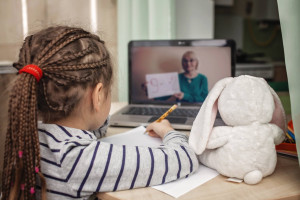COVID-19 ejected students from the familiar hustle and bustle of the classroom into unexpected and prolonged isolation at home. This has destabilized their lives and challenged their sense of self.

It is their identity—who they conceive themselves to be—that they use to forge their ideas of self-worth, and that ultimately guides their decisions and behaviors. These decisions affect them both socially and academically. School was a constant source of messaging that had fed into their sense of self, both positive and negative. Suddenly, that source has been reduced to time-limited, two-dimensional phone and online interactions.
We’ve studied what happens when classrooms feel “identity safe” for students. An identity-safe classroom (online and off) is one in which teachers strive to ensure that a student’s sense of self is an asset rather than a barrier to success in the classroom. The Stanford Integrated Schools Project was a year-long study of 84 classrooms. Observers documented the relationships, questions directed toward students, and use of diverse materials and activities in those classrooms, which we used to determine what approaches and resources were most favorable for learning. The study revealed that in identity-safe classrooms, students felt a greater sense of belonging, welcomed challenging work, and achieved at higher levels in class and on standardized tests.
So, what does an identity-safe classroom look like in a time of school closures and distance learning?
The principles are the same in both in-person and online environments: Rather than working with a colorblind approach and ignoring individual differences in language, race, gender identity, and personal experience, diversity is cultivated as a resource for learning. Together with a challenging curriculum, students come to feel accepted and supported as valued members of the learning community. Social and emotional safety is created by supporting students in exploring, discovering, and defining their identities; refuting negative stereotypes; and giving them a voice within the classroom. This is hard enough to do with students who are sitting right in front of us, but the guiding principles of identity safety can still support educators to serve students of all backgrounds, even if it’s not always clear how to do that.
Here are some ideas for us to live up to the standards of identity safety now, during COVID-19.
Creating a caring online classroom
At this time, teachers can no longer stand outside the door and greet their students with high fives, respond readily to a student confused over a learning concept, or gauge group comprehension with a visual scan across the room.
Yet the promotion of trusting relationships, inclusive interactions, and a sense of belonging remain three important pillars for creating a caring environment, online or otherwise. Engaging in trusting and encouraging relationships allows students to gain confidence and thrive emotionally and academically. A distance-learning environment is more challenging and initially requires more effort—but the level of safety can still be achieved through direct contact with individual students and by setting up warm and caring group interactions.
In order to monitor the pulse of each student, educators can check in regularly by phone or video conferencing to ask them about their feelings and their lives, and to offer feedback on schoolwork. For self-contained classrooms, they can set a schedule for contacting each child. For middle and high schools, teachers can work with colleagues to divide students into manageable groups for check-ins.
Each and every student deserves equal value and treatment, yet due to inequities in access to technologies, many students are falling off the radar and not attending online classes or completing work. While many schools are working hard to provide computers and hotspots, it is not enough. One district remedied this situation by setting up a system to support every student, even if it meant performing home visits, leaving care packages and paper packets while practicing social distancing, and creating a database to track interactions. It is our hope that other districts will follow suit.
For group sessions, educators can create protocols for structured cooperative activities. Community agreements set the norms for ensuring respectful online communication. We can teach social and emotional learning (SEL) skills by articulating core values with a series of questions: What does empathy mean to you? How do you want to feel within an online group? Students can practice reflective listening skills, such as paraphrasing and asking clarifying questions. Teachers can assign roles to foster cooperation (e.g., facilitator, note-taker, timer). These strategies help students feel heard and included and build a solid foundation of trust.
Zoom has a feature called “breakout rooms,” which can be used for structured cooperative activities. Small groups can discuss issues or research projects, work on jigsaws, study different aspects of larger topics—and then report back to the whole group. Teachers can “drop in” to the individual rooms to support learning, and to ensure respectful interactions and full participation. The teacher can ask each breakout group to reflect on how well they worked together before sharing their ideas with the larger group. The whole class can then discuss ways to improve their collaboration.
Inclusion and belonging can be fostered in academic lessons for all grade levels. One second-grade teacher asked each student to find geometric shapes around the house to share at their class meeting. A kindergarten teacher uses the Seesaw Class app to engage her students in video journaling where they can “see” each other’s work when the teacher “turns on” that feature.
Supporting student identity through diversity
In identity-safe classrooms, the diversity among students is valued and differences are celebrated rather than ignored.
Those differences that comprise students’ social identities are many and continually evolving. They encompass everything that makes them unique, including characteristics of their home and school social groups: ethnicity, race, talents, culture, gender, and more. In the real world and online, educators can help students examine and develop different aspects of their social identities and discover their unique voices, which is an essential component of identity safety. They’ll develop confidence and a voice through the belief that who they are—and what they think and say—matters. Drawing from diversity as a resource supports students in developing pride in their backgrounds while accepting and valuing themselves and others.
Amid the uncertainty of the pandemic, students need encouragement and support in strengthening, redefining, and reaffirming their diverse social identities. Teens, especially, may worry about falling behind or losing contact with friends, and become anxious about their future. With support and constructive feedback, educators can express faith in their resilience and their aptitude to reach high expectations, contributing to an increased vitality in their identity.
Journaling is an excellent way for students to track their feelings and promote confidence in their expressions. The U.K.-based Linking Network offers activities to help elementary-level students explore their own identities; Facing History and Ourselves provides activities tailored for teens to do so. Students can also share diverse literature, read stories that focus on acceptance, and discover counter-narratives that empower and give agency to communities that have been marginalized. Interviews with family members, designing family history posters, writing personal narratives to tell stories that go with photos in family albums, or creating videos that show special family artifacts are examples of projects that acknowledge diversity and build a sense of pride.
Identity-safe teaching can be adapted into the current universe of distance learning because it is a flexible approach rather than a program with a fixed set of steps. Relationships and connection come first and lead all other identity-safety features. Creating a sense of identity safety includes recognizing each child’s unique characteristics, strengths, and challenges. We foster identity safety through our screens by valuing the power of that diversity and supporting the ways students are adapting to these new circumstances and overcoming the obstacles they’re meeting. This experience will, we hope, make students even stronger as we move forward and return to in-person teaching. The confidence, resilience, and hope cultivated from identity-safe practices during this pandemic can greatly ease entry into the uncertain times ahead.









Comments